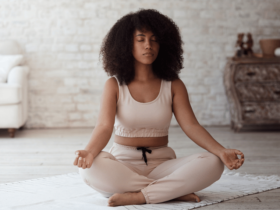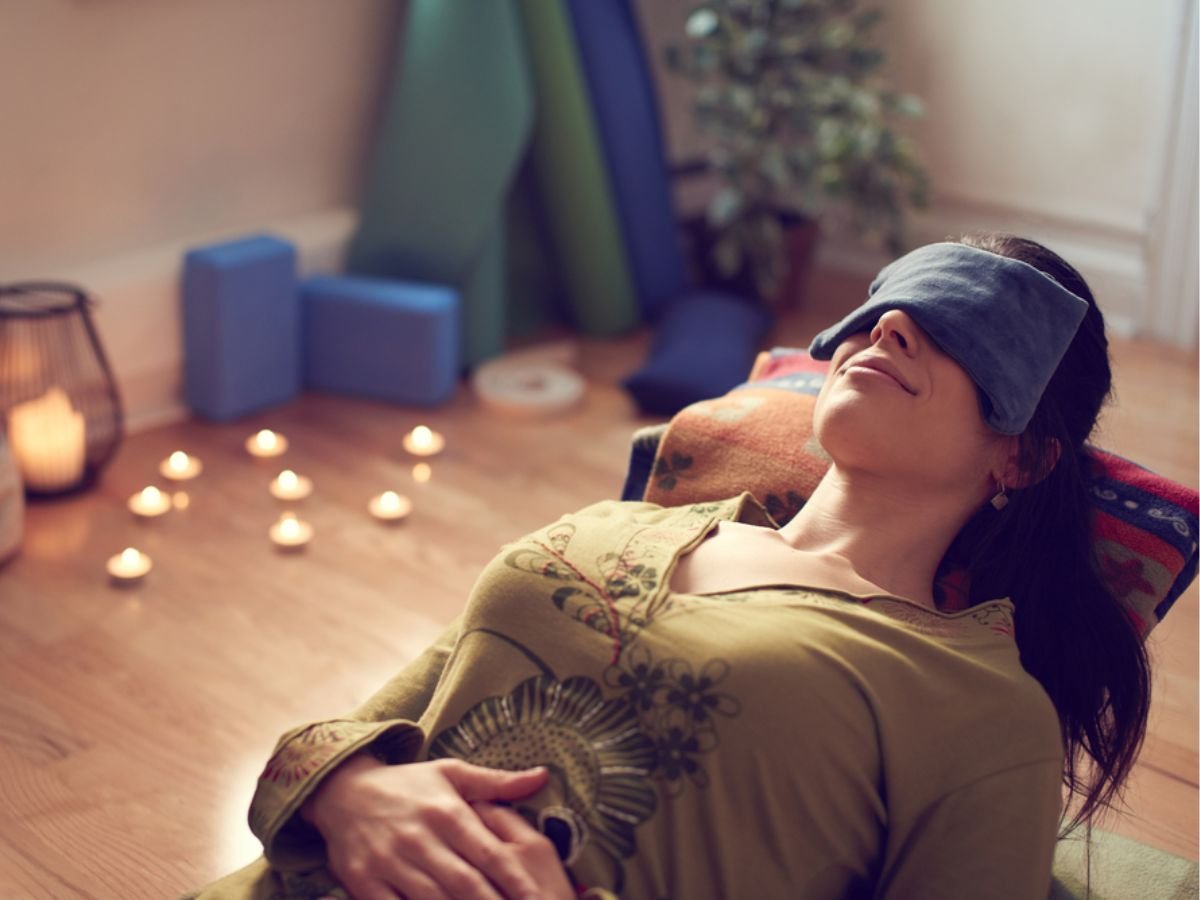Are you struggling with sleep issues? Have you ever spent an entire night tossing and turning? You’re not alone when it comes to restlessness. Sleepless nights can stem from multiple factors, including stress and anxiety. For many, getting enough sleep can feel like an impossible task. But don’t worry, yoga could be the solution! When done correctly, yoga for sleep can address many sleep-related problems. Sounds too good to be true?
Yoga for Relaxation and Better Sleep
Yoga for relaxation is becoming increasingly popular, partly due to the growing awareness of mental health and the understanding of the connection between sleep and overall well-being. Addressing sleep hygiene, as well as factors like anxiety and stress, is crucial for improving sleep quality. According to the Centers for Disease Control and Prevention (CDC), one-third of U.S. adults experience mental and physical issues due to chronic sleep deprivation. If left unaddressed, lack of sleep can contribute to heart disease, diabetes, and other chronic conditions.
Yoga has been practiced for thousands of years and is widely recognized for its ability to relieve stress, relax the body, and improve mental focus. Research shows that yoga can also provide relief from sleep disorders. A study published in The Journal of Clinical Psychology and Sleep Health highlights that yoga can reduce insomnia, improve sleep quality, and regulate the sleep-wake cycle. This is achieved by stimulating the parasympathetic nervous system while inhibiting stress hormones like cortisol.
Moreover, yoga helps enhance concentration and body awareness, which can calm the active mind that often prevents us from falling asleep. When practiced regularly, yoga can ease the transition from the day’s hustle to the peaceful quiet of bedtime.
Ayurvedic Yoga for Better Sleep
Ayurvedic yoga practices can significantly improve sleep quality and even help prevent insomnia. If falling asleep is a struggle for you, it’s time to adopt a simple yet powerful solution: practicing yoga before bed. Yoga doesn’t require hours of commitment—just 15 to 30 minutes of gentle practice each night can transform your sleep. Here are some starting points:
1. Controlled Breathing (5 minutes)
Every countdown starts with a bang! Begin by closing your eyes and preparing to relax. Slowly inhale and exhale, breathing deeply as if you have no worries in the world.
How to Do It:
- Sit cross-legged or lie down, whichever feels most comfortable.
- Close your eyes, inhale deeply through your nose for a count of four, and exhale through your mouth for a count of six.
- Continue breathing deeply for 5 minutes.
Why It Helps: Controlled breathing induces relaxation, which is key to a restful night’s sleep.
2. Forward Bend (Uttanasana) to Release Tension (3-5 minutes)
This yoga asana stretches the hamstrings and soothes the back and neck. Forward bends also calm the nervous system, preparing the body for sleep.
How to Do It:
- Stand with feet hip-width apart and slowly bend at your hips.
- Relax your head and neck, letting them hang down, and place your palms or fingertips on the floor. If necessary, bend your knees slightly to avoid straining your lower back.
- Hold this position for 3 to 5 breaths, allowing your body to stretch deeply.
Why It Helps: This pose activates the parasympathetic nervous system and reduces stress, preparing your body to relax and let go of the day’s tension.
3. Child’s Pose (Balasana) for Calming the Mind (5 minutes)
Child’s Pose is perfect for deep relaxation while stretching the back, hips, and thighs. It also activates the body’s rest response and helps calm the nervous system.
How to Do It:
- Start on all fours and spread your knees apart.
- Gently move your hips back toward your heels and extend your arms forward or rest them by your sides.
- Keep your forehead on the ground and take slow, deep breaths, staying in the pose for 3 to 5 minutes.
Why It Helps: Child’s Pose relieves pressure from the back and hips while promoting relaxation, which can help reduce anxiety.
4. Legs Up the Wall (Viparita Karani) for Relaxation (5-10 minutes)
This gentle inversion helps relieve pressure from the legs and lower back while promoting relaxation throughout the body.
How to Do It:
- Sit with one side of your body against the wall, then lie down and extend your legs upward, placing them against the wall.
- Keep your arms at your sides with palms facing up, and close your eyes.
- Breathe deeply and relax in this position for 5 to 10 minutes.
Why It Helps: Legs Up the Wall enhances relaxation by reversing gravity, reducing stress, and calming the body, which makes it easier to fall asleep.
5. Savasana (Corpse Pose) for Complete Relaxation (5 minutes)
Savasana, typically done at the end of a yoga session, is a great way to fully relax and prepare the body for sleep.
How to Do It:
- Lie on your back with your legs extended and arms resting at your sides.
- Close your eyes and focus solely on your breathing, allowing yourself to relax completely.
- Do nothing—just focus on the deep sense of relaxation for about 5 minutes.
Why It Helps: Savasana allows your body to absorb the benefits of your yoga practice, calming both the body and the mind in preparation for sleep.
Yoga for Better Sleep
Regular yoga practice can improve the quality of your sleep in multiple ways:
- Decreases Tension: Yoga helps reduce cortisol, the stress hormone, leading to a peaceful mind that is better prepared for sleep.
- Calms the Body: Deep breathing, stretching, and relaxation techniques calm the nervous system, creating an optimal state for sleep.
- Aids Sleep Disorders: Yoga can help regulate circadian rhythms, which are essential for falling asleep and waking up at the right times.
- Reduces Physical Tension: Tight muscles, especially in the shoulders, back, and knees, can hinder sleep. Yoga helps release this tension, making it easier to rest.
- Increases Melatonin Levels: Restorative yoga has been shown to increase melatonin, a hormone that regulates sleep.
Common Pitfalls or Mistakes to Avoid
While yoga for sleep can be highly effective, there are a few common mistakes people make that can hinder its benefits:
- Overexerting Yourself: Yoga should be a relaxing practice, especially before bed. Avoid vigorous or intense poses that may raise your heart rate and energize the body instead of calming it.
- Practicing Too Close to Bedtime: While a gentle yoga practice can promote sleep, avoid doing it right before bed if it leaves you feeling overly alert. Allow at least 30 minutes between your practice and bedtime.
- Skipping Breathwork: Breathing is a crucial part of yoga for sleep. If you focus only on the physical postures without incorporating deep breathing, you might miss out on the full calming benefits.
- Not Consistent Enough: For the best results, yoga should be practiced regularly. Doing a single session here and there may not be as effective as making yoga part of your nightly routine.
Final Thoughts:
Yoga for sleep offers a natural and effective way to promote relaxation, reduce stress, and improve the quality of your sleep. By incorporating gentle poses, deep breathing, and mindfulness into your evening routine, you can create the perfect environment for restful, restorative sleep. If you struggle with sleepless nights, try adding yoga to your nighttime ritual and see how it works for you. Share your experiences in the comments below or ask any questions you might have!
















2 Comments
View Comments